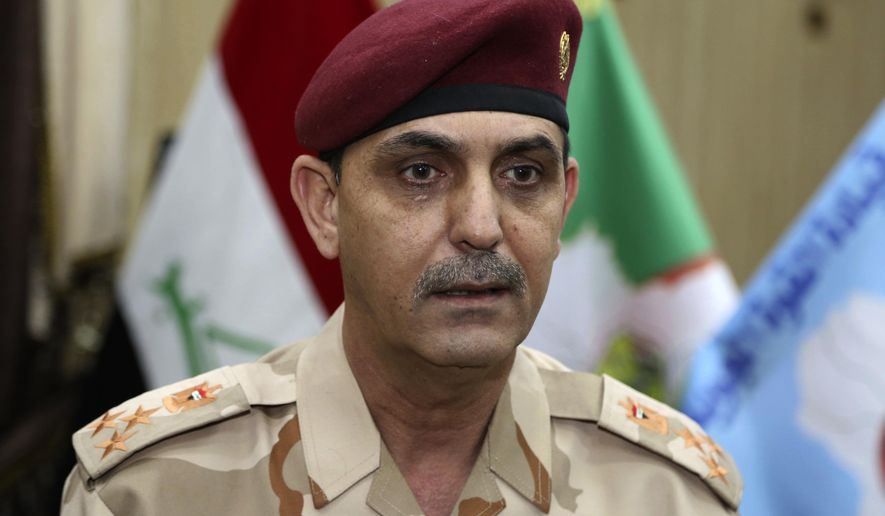BAGHDAD (AP) - U.S. airstrikes probably played a role in the deaths of dozens of civilians in Mosul earlier this month, U.S. and Iraqi military officials acknowledged Tuesday, but they denied the rules for avoiding civilian casualties have been loosened despite a recent spike in civilian casualties.
Speaking from Baghdad to reporters at the Pentagon, the top commander of U.S. forces in Iraq said an ongoing investigation may reveal a more complicated explanation for the March 17 explosion that residents say killed at least 100 people, including the possibility that Islamic State militants rigged the building with explosives after forcing civilians inside.
Army Lt. Gen. Stephen Townsend said a recent spate of civilian casualties in Mosul was “fairly predictable” given the densely populated urban neighborhoods that the IS fighters are defending against Iraqi government troops. But the civilian deaths cannot be attributed to any loosening of American military rules of combat, he said, and Washington hasn’t decided to tolerate greater risk of civilian casualties in U.S. airstrikes.
Amnesty International on Tuesday said the rising death toll suggested the U.S.-led coalition wasn’t taking adequate precautions as it helps Iraqi forces try to retake the city.
Townsend acknowledged the U.S. conducted multiple airstrikes in the area of the explosions. That, coupled with initial inquiries done by U.S. technical experts who visited the scene, led him to say: “My initial assessment is that we probably had a role in these casualties.”
But Townsend said the type of munitions used by the U.S. in the airstrikes should not have been able to bring down the entire building, raising questions about the level of American involvement. He said U.S. officials were assessing the possibility that IS forced civilians to gather there to act as human shields or to lure the U.S. into attacking.
“It sure looks like they were,” Townsend said. Another possibility that was being examined was that the militants filled the building with explosives, he said.
In the most extensive U.S. explanation of what is known about the event, Townsend stressed that no one should think it was a deliberate U.S. act. “If we did it - and I’d say there is at least a fair chance we did - it was an unintentional accident of war,” he said.
Iraq’s ministry of defense also blamed IS for the high civilian death toll.
“As our forces advanced toward that area to liberate it, the explosive-laden tanker truck headed toward our advancing troops, it was targeted by an airstrike which led to a huge explosion. The explosion damaged number of buildings, including the one where IS crammed about 130 civilians,” said the ministry’s spokesman, Brig. Gen. Yahya Rasool.
IS planned the incident to “impact the civilians, to inflame the public and to convey a wrong message to the world that the joint forces and the international coalition are behind the killing and bombings,” Rasool said.
The fight for western Mosul began in February after Iraqi security forces pushed IS out of the eastern side of the Tigris River city. In recent weeks, IS defenders have packed into neighborhoods with narrow streets and trapped civilians, Townsend said.
“It is there that the enemy has invested two-and-a-half years of defensive preparations,” he said, calling it the “toughest phase” of the war.
“I think that’s really the explanation for the civilian casualties,” Townsend added. “Although our partners and the coalition have made mistakes that harmed civilians, we have never targeted them - not once.”
In report released Tuesday, Amnesty International said the spike in civilian casualties in Mosul suggests the U.S.-led coalition was not taking adequate precautions to protect civilians. It cited a second strike Saturday that it said killed up to 150 people.
Evidence gathered on the ground in Mosul “points to an alarming pattern of U.S.-led coalition airstrikes which have destroyed whole houses with entire families inside,” the Amnesty report said. It said any failure to take precautions to prevent civilian casualties would be “in flagrant violation of international humanitarian law.”
Speaking to reporters in Geneva, the spokesman of the U.N. human rights office, Rupert Colville, said the agency has tallied the deaths of at least 307 people between Feb. 17 and March 22, including 140 from the March 17 airstrike.
IS militants were brazenly using civilians as human shields, Colville said, and urged the coalition to “avoid this trap.”
Civilians, humanitarian groups and monitoring officials have repeatedly warned of the possibility of increased civilian casualties in western Mosul due to the higher density of the population there and the increased reliance on airstrikes and artillery. Faced with their toughest fight against IS yet, Iraqi and coalition forces have increasingly turned to airstrikes and artillery to clear and hold territory in Mosul’s west.
Unlike in previous battles against IS in urban settings in Iraq, the government instructed Mosul civilians to remain in their homes, to prevent large-scale displacement. In the battles for Fallujah and Ramadi, those cities were entirely emptied of their civilian population while Iraqi forces fought to push out IS.
When the operation to retake Mosul was launched in October, more than a million people were estimated to still be living in the city, Iraq’s second-largest. Today, the United Nations estimates about 400,000 people remain trapped in IS-held neighborhoods in western Mosul.
___
Associated Press writer Sinan Salaheddin reported this story in Baghdad and AP writer Robert Burns reported from Washington. AP writers Ahmed Sami in Baghdad and Jamey Keaten in Geneva contributed to this report.




Please read our comment policy before commenting.